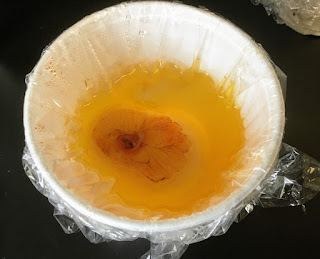Sunday, April 30, 2017
Egg-less Chicken Embryos and Real Science
Trying a lab for the first time is a great learning experience. Sometimes we use labs that "work", but it doesn't give us the chance to think through how we could improve an experiment or procedure we've tried to figure out. The students hear from me that real science is trying experiments over and over, making tweaks, and sometimes going back to the drawing board altogether. Trying to hatch egg-less chicks has been a great experience in working on procedure.
Students had a chance to try again when the yolk broke, or the egg was rotten, and because of it, they became more confident in what they were doing. Finally having some success was very exciting. And to see the embryo development that happened in just one day was amazing. I am regretting not going into school on Saturday since when I checked Sunday our best embryo had made so much progress. I don't know that it will progress much further though, since it looks like the yolk has broken. I'm still impressed with the development that we were able to see, and now we have more ideas of what to try to make it better.
One of the problems we encountered was too many cups in the oven--next time, no more than 7 since cramming 8 in lifted some of the petri dishes. The embryos with the lifted petri dishes dried out and died. Also, we should only use the eggs with embryos that have made it to the stage of seeing the heart beating. The younger embryos did not progress well for us. I'm also hypothesizing that it would be better to err on the side of the oven temperature being on the low side instead of on the high side. One last change was to not push down the plastic wrap as low, so the egg is closer to the top of the cup. The theory is that it will leave less air for the moisture of the egg to evaporate into. We're trying to stop dry-out.
Subscribe to:
Post Comments (Atom)



Hi! I'm a high school biology teacher myself and am very interested in doing this lab. I hope to test it out this summer and implement it in the new school year. Did you run into any ethical or legal problems with using live vertebrate specimen?
ReplyDeleteAny other tips for someone who'll be trying it out for the first time?
Thanks!
I didn't run into any legal issues, but I'll have to look into it. One student in another class expressed concern that without an egg shell for it to break through, its beak wouldn't finish its proper development. I was pretty sure that we wouldn't get quite that far. We did leave two eggs whole and one of them hatched last week. I was surprised at the excitement from all the seniors (and most of the kids in the middle school and high school). The chick, who my seniors named "Kahoot" is now safely back with a real chicken family. =)
ReplyDeleteOne other thing that I'd like to try next year is not to open the lid of the cup to take pictures. Our key problem seemed to be the embryos drying out.
How many days into development did your shell-less embryos last? Thanks!
ReplyDeleteOnly 6 or 7 days. Still gave us some awesome pictures.
DeleteI did some research today about any legal issues and saw in one source that chicken embryos are not considered live animals. I also found an article in The American Biology Teacher from Nov/Dec 2012 titled Multidisciplinary Inquiry-Based Investigation Learning Using an Ex Ovo Chicken Culture Platform: Role of Vitamin A on Embryonic Morphogenesis that set up the chicken eggs a little differently. I might try it. After we have longer success, I may even try the vitamin A experiments it talks about.